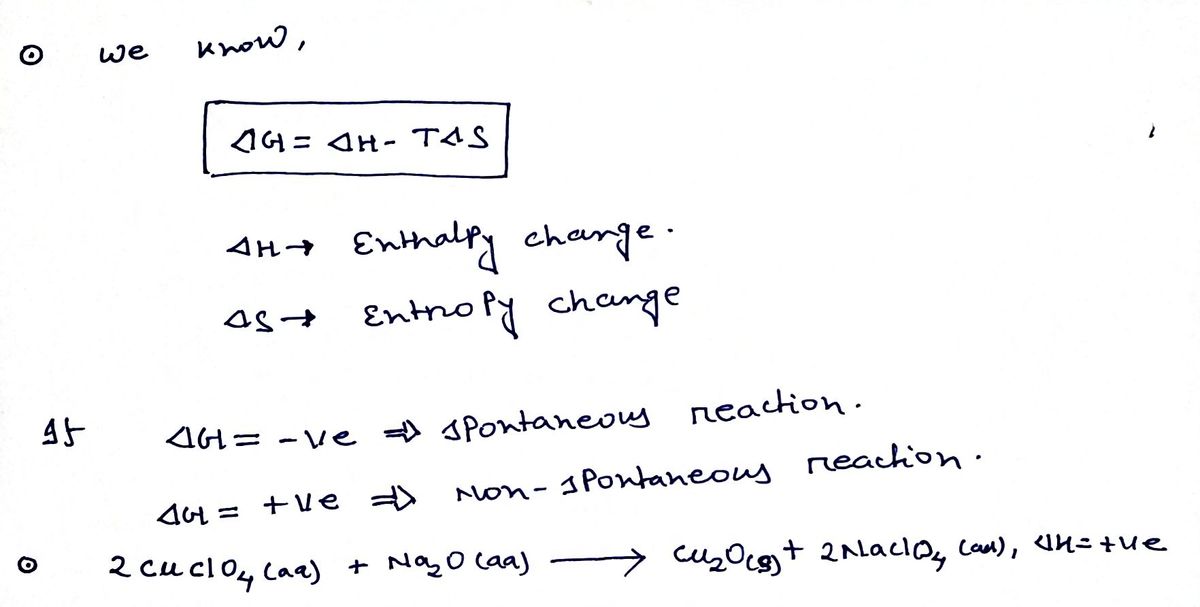For the reaction below, which statement best describes what is happening with the sign of ΔG0? 2 C u Cl O4(a q) + N a2O(a q) → C u2O(s) + 2 N a Cl O4(a q) (endothermic) The reaction is spontaneous at all temperatures. The reaction is non-spontaneous at low temperature and spontaneous at high temperature. The reaction is spontaneous at low temperature and non-spontaneous at high temperature. The reaction is non-spontaneous at all temperatures.
For the reaction below, which statement best describes what is happening with the sign of ΔG0? 2 C u Cl O4(a q) + N a2O(a q) → C u2O(s) + 2 N a Cl O4(a q) (endothermic) The reaction is spontaneous at all temperatures. The reaction is non-spontaneous at low temperature and spontaneous at high temperature. The reaction is spontaneous at low temperature and non-spontaneous at high temperature. The reaction is non-spontaneous at all temperatures.
Chemistry by OpenStax (2015-05-04)
1st Edition
ISBN:9781938168390
Author:Klaus Theopold, Richard H Langley, Paul Flowers, William R. Robinson, Mark Blaser
Publisher:Klaus Theopold, Richard H Langley, Paul Flowers, William R. Robinson, Mark Blaser
Chapter16: Thermodynamics
Section: Chapter Questions
Problem 3E: Indicate whether the following processes are spontaneous or nonspontaneous. (a) Liquid water...
Related questions
Question
For the reaction below, which statement best describes what is happening with the sign of ΔG0?
2 C u Cl O4(a q) + N a2O(a q) → C u2O(s) + 2 N a Cl O4(a q) (endothermic)
|
|
The reaction is spontaneous at all temperatures. |
|
|
The reaction is non-spontaneous at low temperature and spontaneous at high temperature. |
|
|
The reaction is spontaneous at low temperature and non-spontaneous at high temperature. |
|
|
The reaction is non-spontaneous at all temperatures. |
Expert Solution
Step 1

Step by step
Solved in 2 steps with 2 images

Knowledge Booster
Learn more about
Need a deep-dive on the concept behind this application? Look no further. Learn more about this topic, chemistry and related others by exploring similar questions and additional content below.Recommended textbooks for you

Chemistry by OpenStax (2015-05-04)
Chemistry
ISBN:
9781938168390
Author:
Klaus Theopold, Richard H Langley, Paul Flowers, William R. Robinson, Mark Blaser
Publisher:
OpenStax

Chemistry: Principles and Practice
Chemistry
ISBN:
9780534420123
Author:
Daniel L. Reger, Scott R. Goode, David W. Ball, Edward Mercer
Publisher:
Cengage Learning

Chemistry: The Molecular Science
Chemistry
ISBN:
9781285199047
Author:
John W. Moore, Conrad L. Stanitski
Publisher:
Cengage Learning

Chemistry by OpenStax (2015-05-04)
Chemistry
ISBN:
9781938168390
Author:
Klaus Theopold, Richard H Langley, Paul Flowers, William R. Robinson, Mark Blaser
Publisher:
OpenStax

Chemistry: Principles and Practice
Chemistry
ISBN:
9780534420123
Author:
Daniel L. Reger, Scott R. Goode, David W. Ball, Edward Mercer
Publisher:
Cengage Learning

Chemistry: The Molecular Science
Chemistry
ISBN:
9781285199047
Author:
John W. Moore, Conrad L. Stanitski
Publisher:
Cengage Learning

Chemistry
Chemistry
ISBN:
9781305957404
Author:
Steven S. Zumdahl, Susan A. Zumdahl, Donald J. DeCoste
Publisher:
Cengage Learning

Chemistry: An Atoms First Approach
Chemistry
ISBN:
9781305079243
Author:
Steven S. Zumdahl, Susan A. Zumdahl
Publisher:
Cengage Learning
